The HTC One (M8) Review
by Anand Lal Shimpi & Joshua Ho on March 26, 2014 7:00 PM EST- Posted in
- Smartphones
- HTC
- Mobile
- HTC One
Subtle Cheating: New Benchmark Optimizations
We’ve been tracking the state of benchmark optimizations among Android OEMs for a while now. It wasn’t too long ago that we published a piece calling out nearly all Android OEMs for optimizing for benchmarks. The optimizations are pretty crude. Upon detecting a whitelisted benchmark by APK identifier alone, most OEMs would enable a performance mode that would:
1) Plug in all CPU cores
2) Run all cores at max frequency
3) Raise thermal limits to eliminate/reduce throttling
Defeating the optimization was just as simple: thorough renaming of the benchmark and all internal application IDs. For the past several months we’ve been working with benchmark, silicon and handset vendors to curb the behavior. Although we found the optimizations to have minimal impact on our test results, it’s still a messy practice that isn’t worth doing.
We’ve seen early (encouraging) indications that some vendors have reconsidered their position on benchmark optimizations. Unfortunately HTC isn’t quite there yet.
The M8’s Android 4.4.2 build includes a new, more subtle form of benchmark optimization that we hadn’t seen in previous devices. Benchmarks are still detected according to their application identifier, but instead of hot plugging in all CPU cores and driving them to max frequencies, everything appears to be normal at launch.
Here’s the state of the CPU cores after launching the Play Store version of any optimized benchmark:
Everything looks just fine. But look at what happens if we monitor CPU frequency over time on the Play Store and a special renamed version of 3DMark:
Average CPU frequency is about 15% higher while running the Play Store version of 3DMark. I still need to run some thermal analysis on the device but I don’t think HTC is raising thermal limits. Instead what appears to be happening is HTC is simply more aggressively tuning the governor response to performance demands, allowing for higher frequencies. Note that the frequency response latency is now so low that I couldn't even grab the 300MHz screenshot above in the Play Store version of 3DMark. As soon as the device detected a button press it would ramp up to 1.7GHz.
The impact on performance goes hand in hand with the increase in average clock speed. I measured performance during 3DMark’s Physics test (which is CPU bound). The difference was about 15%.
I also tracked GPU clock speed over time. Thankfully the optimization seems limited to CPU frequencies alone:
The list of optimization targets has also expanded since we last looked at HTC. The latest versions of GFXBench, BaseMark X and BaseMark OS II are now included in the benchmark whitelist.
HTC made one small concession - it’s allowing users the ability to run their device in this high performance mode at all times. Under developer tools (tap on the build number 5 times in Settings > About > Software information > More), you’ll find an option to enable high performance CPU mode. Checking that box will put your device in the same mode that’s enabled when a whitelisted benchmark is detected.
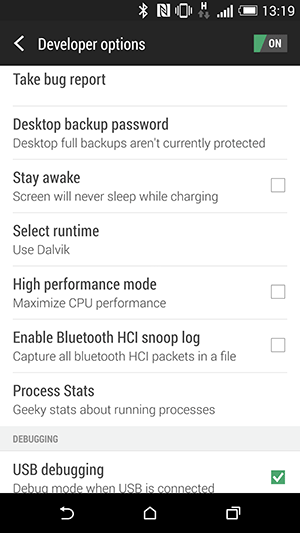 |
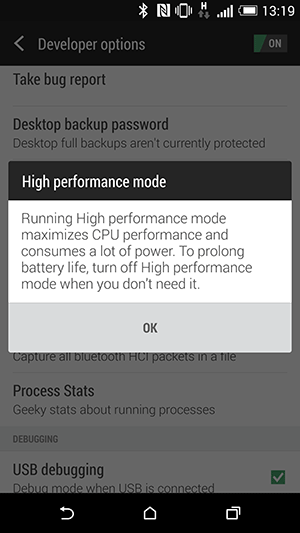 |
I do appreciate that HTC is exposing the optimization control, the only thing missing is the ability to toggle the benchmark optimization off (not to mention that I’d prefer if it was disabled to begin with). I fear that HTC’s justification in all of this is that everyone else is doing it so why opt out. The reality seems to be trending the other direction however. We’ll have to see what Samsung does with the Galaxy S 5, but I have a feeling that HTC is going to end up on the wrong side of history with this move. All of our benchmarks are already immune to the optimization, so it’s really a matter of sacrificing integrity for no real gain. There’s nothing more to say other than I’m disappointed.


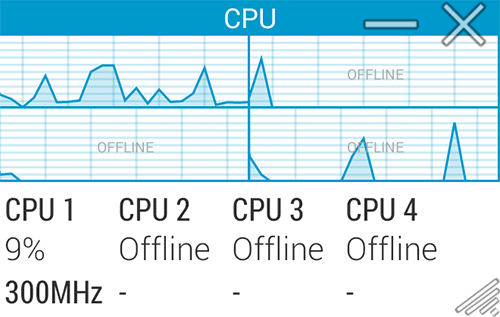
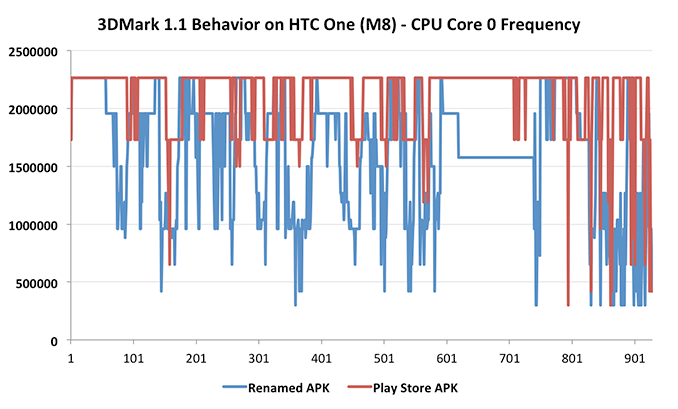
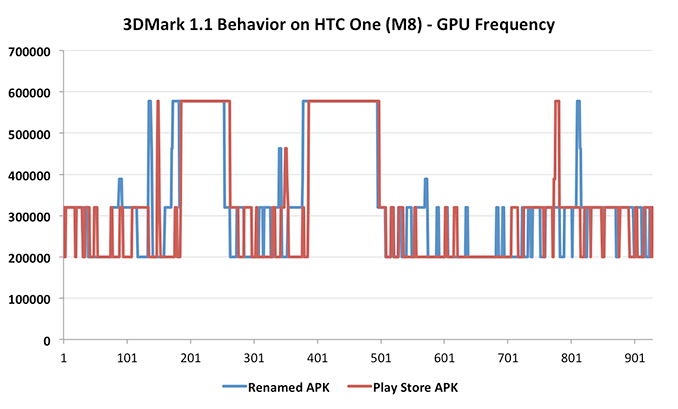








222 Comments
View All Comments
doosh bag - Thursday, March 27, 2014 - link
In order for HTC to build this phone with the "6-8 megapixel" people keep screaming they can't live without, they would've had to raise the price considerably to make the phone profitable. Don't forget HTC's revenues were down almost 50% in Q4 2013 from Q4 2012. It's quite easy for people to sit around in the comment box of someone else's blog and wax intellectual about how to spend HTC's money. If this phone sells like the M7, we may not see a M9.Death666Angel - Friday, March 28, 2014 - link
Lose the second camera, lose the expensive all metal unibody, which obviously people don't need (look at other top selling smartphones) and give me the 6-8MP Ultrapixel sensor for the same price. There, I solved your problem. Now HTC has just done "more of the same" while giving us "less of some stuff". Of a phone that probably wasn't a big hit, or else they would be doing better. I don't understand their strategy at all.evonitzer - Saturday, March 29, 2014 - link
Heck, lose the 801 (who needs that performance anyway), lose the Wifi AC (impossible to find in the wild), cut the screen resolution (nobody needs more than qHD say I) ... what else can I cut and still have a phone? LTE! Get rid of it.Seriously, what's the point of innovating or trying. Just be boring and people will buy it.
jospoortvliet - Sunday, March 30, 2014 - link
I sure as he'll wouldn't have bought it if it was another plasticy piece of crap like the Samsung's... Their strategy is fine, they just need more/better priced midrange phones.hero4hire - Sunday, March 30, 2014 - link
Exactly. It's not like the consumer is footing the bill for the all metal vs plastic. If there was a tradeoff for metal & 4mp or vs plastic 16mp "ultra" it would be worth a discussion. Maybe they could make that phone too. I d bet we find s5 and one (2014) for the same USA subsidy price as is.CoryWeston101 - Monday, March 31, 2014 - link
Cut the metal unibody? You are a daft one.LAWSON72 - Wednesday, March 26, 2014 - link
S5 for water proof and less to worry about since it is plastic, or this for the beautiful metal design, and touchscreen nav buttons. A tough decision, I just know I am getting bored with my S4 and the Nexus 5 sadly is not ever going to be on Verizon, so it is a choice between these two.antef - Wednesday, March 26, 2014 - link
Curious why you're "happy to see a move to nano sim as well." What difference or advantage does it make for the consumer? They can be harder to find on pre-paid carriers. Seems like it only exists due to Apple's relentless desire to always be using something different from everyone else.Braumin - Wednesday, March 26, 2014 - link
Simple. Nano sim in this case made room for dual sim on some models, and likely freed up space for micro SD, although making the body taller likely helped too.Plus the nano sim was made a standard so why not? You can make the argument it's the wrong standard, but it won out.
antef - Thursday, March 27, 2014 - link
I don't think "micro SIM being too big" was ever a reason for excluding things like micro SD slots, that decision is mostly made for other reasons and HTC probably just included it this time to try to differentiate some. I'm okay with a new standard if it's universally available, but until recently and maybe even now that hasn't been the case (again regarding pre-paid carriers).